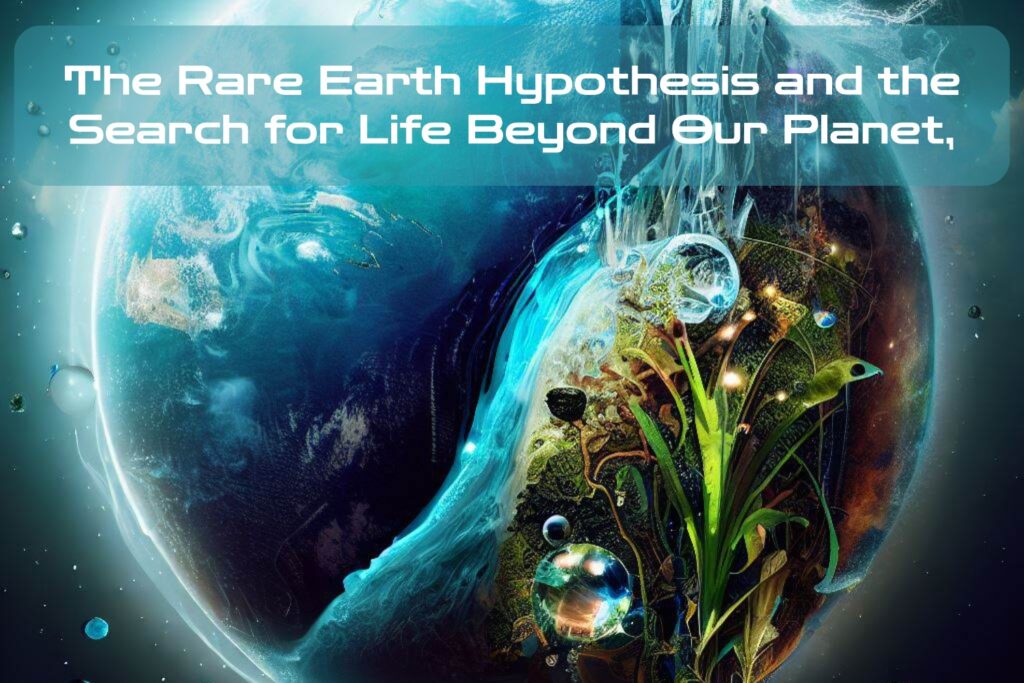The Rare Earth hypothesis is a scientific theory that suggests that complex life, like humans, is relatively rare in the universe. This hypothesis argues that the combination of factors required for life to exist on a planet, such as a stable climate, plate tectonics, and a magnetic field to protect against solar radiation, are so specific and rare that they only occur on planets like our own. Therefore, Earth may be unique in its ability to support complex forms of life.
The main proponents of this theory are paleontologist Peter Ward and astronomer Donald Brownlee. In their book “Rare Earth: Why Complex Life Is Uncommon in the Universe,” they present evidence from geology, biology, and astronomy to argue that complex life may be an anomaly in the grand scheme of things.
The Importance of Search for Extraterrestrial Life

The search for extraterrestrial life has fascinated scientists for centuries. It is a question that has puzzled us since we first realized we were not alone in the universe. The possibility of discovering life beyond our planet could revolutionize our understanding of biology and evolution.
It could also have profound philosophical implications about our place in the cosmos. Furthermore, finding intelligent extraterrestrial life would have significant technological ramifications.
It could lead to advances in fields such as communication technology or propulsion systems based on alien technology. But beyond these potential benefits lies something even more fundamental – answering perhaps one of humanity’s most fundamental questions: Are we truly alone?
The conditions that make Earth habitable

What makes planet Earth so special? It’s the only celestial body we know of that can support such diverse and complex life forms. Scientists have identified many reasons why the Earth is capable of supporting life, and these include a wide range of factors.
Distance from the sun
Earth is located in what astronomers call “the Goldilocks Zone,” which means it’s situated just right for life to exist. This distance is perfect for liquid water to exist on the surface, which is essential for all types of living organisms. If Earth were too close to or too far away from the sun, our oceans would either boil away or freeze solid.
Magnetic field
Another important factor in making the Earth habitable is its magnetic field. Our planet has a strong magnetic field, which deflects most of the harmful particles coming from space – particularly those emanating from solar flares. Without this protective shield, our atmosphere could be stripped away over time.
Plate tectonics
Plate tectonics is another factor that contributes to making the Earth habitable. The movement of these plates
- redistributes material between land and sea (which balances out carbon dioxide levels),
- creates mountains (which leads to weather patterns),
- and provides an essential source of volcanic activity (which contributes nutrients).
Without plate tectonics, none of these things would happen.
Comparison with other planets and their lack of habitability

While there are billions upon billions of planets in our galaxy alone, most are not suitable for life as we know it. Let’s take a look at some other bodies in our solar system, as well as planets discovered around nearby stars.
Mars
Mars was once considered one of the most likely candidates for hosting extraterrestrial life, but as we have learned more about the planet, this seems increasingly unlikely. While there is evidence of water on the planet’s surface, it is extremely cold and thin – not suitable for sustaining life.
Venus
Venus is often called Earth’s “sister planet” due to its similar size and location in our solar system. However, it has a thick atmosphere that traps heat from the sun – making it one of the hottest planets in our solar system. The atmosphere also contains sulfuric acid clouds, making it even more inhospitable.
Exoplanets
Astronomers have discovered thousands of exoplanets orbiting other stars, but only a tiny fraction of them are believed to be habitable. Many are “super-Earths,” which are too massive to support life as we know it. Others orbit too close (or too far) from their parent star and experience extreme temperatures.
Earth’s habitability can be attributed to a number of factors, such as distance from the sun, magnetic field and plate tectonics- factors that allow for diverse life forms on Earth. This makes Earth unique in our solar system and rare in comparison to most exoplanets we know so far- planets that are mostly barren rocks or gas giants devoid of any complex life forms such as plants or animals.
The Rare Earth hypothesis and its implications for extraterrestrial life

The Rare Earth hypothesis was outlined in “Rare Earth: Why Complex Life is Uncommon in the Universe” in 2000.
The book argues that while simple life may be common, complex life, like that of humans, is incredibly rare. The main argument put forth by the Rare Earth hypothesis is that several factors must align perfectly for complex life to develop on a planet.
These factors include being in the right location within a galaxy, having a stable and long-lasting star, possessing a large moon to stabilize climate, having plate tectonics to regulate carbon dioxide levels, maintaining a magnetic field to protect from solar radiation, and possessing an active system of Jupiter-sized gas giants to deflect comets and asteroids. This hypothesis has major implications for the search for extraterrestrial life.
If the conditions necessary for complex life are as rare as suggested by this theory, then it limits our expectations of finding other advanced civilizations within our own galaxy. However, it also encourages us to explore exoplanets with similar conditions to Earth that could potentially support complex life.
Limits our expectations on finding intelligent life in our galaxy
The Rare Earth hypothesis posits that planets capable of supporting complex life like humans are incredibly rare due to specific requirements such as being located in the right position within their galaxy and possessing certain characteristics such as plate tectonics and magnetic fields. This means that if we were hoping to find other advanced civilizations within our own Milky Way galaxy based on our own existence as evidence of their possibility, we may be sorely disappointed.
It’s important not to completely rule out the possibility of intelligent extraterrestrial life existing elsewhere in our universe – but this hypothesis does suggest that the odds of us finding it within our own galaxy may be much lower than previously expected. This realization has implications for how we approach the search for extraterrestrial life, as we may need to broaden our scope beyond just our own galaxy or focus on planets with specific conditions that are more likely to support complex life.
Encourages exploration of exoplanets with similar conditions to Earth
Despite limiting our expectations of finding intelligent extraterrestrial life within our own galaxy, the Rare Earth hypothesis also encourages us to explore exoplanets with conditions similar to Earth. The hypothesis asserts that several factors need to align perfectly for complex life to exist on a planet, and it’s possible that there are other planets out there that share these same conditions.
This means that by focusing on planets with Earth-like characteristics, we may be more likely to find signs of habitability or even complex life. Several missions, such as Kepler and TESS, have already been launched in pursuit of these types of planets, and it’s hoped that continued research will help shed light on whether or not the Rare Earth hypothesis is accurate in its assessment of how common complex life is in the universe.
Criticisms and Alternatives to the Rare Earth Hypothesis

Counterarguments against the Rare Earth hypothesis
The Rare Earth hypothesis has been controversial since its inception, with some scientists expressing their skepticism over its validity. One of the main counterarguments is that it is too early in our search for extraterrestrial life to conclude that complex life is rare in the universe.
The universe is vast, and we have only just begun to explore it. It could be possible that we have not found any evidence of intelligent life yet simply because we haven’t looked hard enough or used the right methods.
Additionally, some scientists also point out that the Rare Earth hypothesis has focused on Earth as a blueprint for habitable planets. This narrow-minded approach ignores other possible ways for planets to become habitable.
For example, recent studies suggest that moons orbiting gas giant planets could potentially support life due to their subsurface oceans. In this case, planetary conditions may not necessarily need to be like those of Earth for habitability.
Other hypotheses suggest there may be other ways for planets to become habitable
While the Rare Earth hypothesis suggests that very specific conditions are necessary for complex life forms to emerge on a planet, some alternative hypotheses suggest there may be other ways for planets to become habitable.
One such hypothesis is called the “Panspermia theory,” which suggests that microbial life could have been seeded across different planets through impacts from asteroids and comets.
Another alternative explanation comes from simulations of chemical reactions in space environments, which show organic molecules can form under certain conditions, as seen in meteorites and comets.
This raises the possibility of these molecules being transported throughout space by comets or asteroids and seeding other worlds as well. Regardless of these possibilities, however, it remains clear that much more research needs to be done before we can say anything conclusive about how rare or common life might be in our universe.
Implications for future research and space exploration

The Rare Earth hypothesis, despite its criticisms, has highlighted the need for continued research in astrobiology and exoplanetology. The search for extraterrestrial life is a multifaceted endeavor that requires a lot of resources, both in terms of funding and expert personnel.
We need to continue investing in better technology to detect these planets more accurately. In addition, the development of new telescopes such as the James Webb Space Telescope allows us to study the atmospheres of exoplanets more closely – another crucial step towards understanding their habitability.
But beyond just finding habitable planets, we must also develop ways to explore them more effectively. This may involve sending robotic probes capable of autonomously collecting data over long periods of time or even sending manned missions into space.
In any case, it is clear that the search for extraterrestrial life is far from over. With continued research and exploration, we may finally answer one of mankind’s most profound questions: are we alone in the universe?
Importance of Continued Research in Astrobiology and Exoplanetology

Continued research in astrobiology and exoplanetology is essential not only for discovering extraterrestrial life but also for understanding our own planet’s place in the universe. By studying other planets, we gain insight into how unique Earth truly is and what factors contributed to its habitability. Furthermore, advancements in these fields have numerous practical applications beyond just discovering alien life.
For example, understanding habitability can help us prepare for long-duration space missions by identifying what resources are necessary for human survival outside of Earth’s atmosphere. Additionally, research into exoplanet atmospheres may help us refine models predicting climate change on Earth.
Current Missions Searching for Potentially Habitable Exoplanets
Currently, there are several missions underway specifically designed to search for potentially habitable exoplanets.
The Kepler mission has already discovered thousands of potential candidates since its launch in 2009 (retired, 2018).
The Transiting Exoplanet Survey Satellite (TESS) launched in 2018 and is currently scanning the sky for exoplanets using a similar method to Kepler.
The upcoming Europa Clipper mission, scheduled to launch in the mid-2020s, will explore Jupiter’s icy moon Europa. While not strictly an exoplanet mission, Europa has been identified as a prime candidate for harboring life beyond Earth due to its subsurface ocean.
Final Thoughts
While the Rare Earth hypothesis may suggest that intelligent life is exceedingly rare in the universe, there are still countless planets out there waiting to be explored. Continued research in astrobiology and exoplanetology will help us better understand what it takes for a planet to be habitable and where our best chances of finding life beyond Earth might be. While we may not have all the answers yet, every discovery brings us one step closer to unlocking the secrets of the universe.

C M, a seasoned editor, journalist, and consultant, is deeply fascinated by the convergence of technology, space, and the future of humanity.
With a particular interest in transhumanity, futurology, and the philosophical and ethical dimensions of these domains, C M serves as the lead contributor to SpaceSpotlight and TranscendSphere.
When not penning insightful articles on these rapidly evolving fields, C M indulges in their love for podcasts and books, proudly embracing their status as a ‘Happy Nerd Extraordinaire!’



